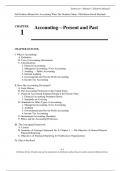Exam (elaborations)
Solution Manual for Accounting What The Numbers Mean, 13th Edition By David Marshall 2024 | All Chapter's 1 - 16 | A+
- Module
- Institution
- Book
Instructor’s Manual / Solution Manual for Accounting What The Numbers Mean, 13th Edition By David Marshall 2024 | All Chapter's 1 - 16 | A+ CHAPTER 1 Accounting—Present and Past CHAPTER OUTLINE: I. What Is Accounting? A. Definition B. Uses of Accounting Information C. Classifications 1...
[Show more]



